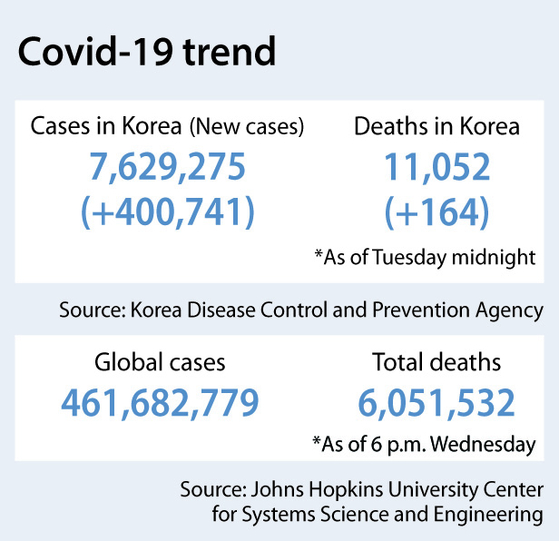400,741 Covid cases is higher than gov't predicted
Published: 16 Mar. 2022, 16:49
Updated: 16 Mar. 2022, 20:07
![Staff at the Gwangjin District Emergency Management Agency in eastern Seoul monitor Covid-19 patients on Wednesday. Starting on that day, Covid-19 patients in their 50s with underlying diseases were excluded from intensive care groups and have to receive at-home treatment. [YONHAP]](https://koreajoongangdaily.joins.com/data/photo/2022/03/16/9a1b6124-5393-47b9-914b-c99f27fca93e.jpg)
Staff at the Gwangjin District Emergency Management Agency in eastern Seoul monitor Covid-19 patients on Wednesday. Starting on that day, Covid-19 patients in their 50s with underlying diseases were excluded from intensive care groups and have to receive at-home treatment. [YONHAP]
Korea’s steepest Covid-19 surge shows no signs of subsiding as cases hit a record 400,741 Wednesday with rapid antigen test results included in the calculation.
Of Wednesday’s cases, all but 117 were locally transmitted, raising the total to 7,629,275, according to the Korea Disease Control and Prevention Agency (KDCA).
Wednesday's record is partly the result of more tests being conducted, with the inclusion of positive results from rapid antigen tests conducted by medical professionals. Previously, the country only counted the results from standard polymerase chain reaction (PCR) tests conducted at a limited number of public health centers, like district or gu offices. Since Tuesday, results from rapid antigen tests conducted at local hospitals and clinics were included.
Since cases first topped 100,000 on Feb. 18, it took 12 days to reach 200,000. It took another week to cross the 300,000 mark, and seven days to exceed 400,000. The pace is faster and the number of cases higher than the government’s prediction. It expected cases to peak at around 372,000 this week.
“The Omicron wave seems to have reached its peak, with more than 30 percent of the cumulative Covid-19 caseload infected in the past week,” Prime Minister Kim Boo-kyum said in a virus meeting on Wednesday. “Experts predict that the peak will soon come to an end.”
Worldometer's coronavirus dashboard showed that 25.8 percent of the world’s 1,202,401 new Covid-19 cases on Tuesday were in Korea. This means one in four new virus patients around the world was in Korea.

The number of hospitalized Covid-19 patients in critical condition is reaching a new high every day, climbing 48 from the previous day to reach 1,244 as of Wednesday midnight. The figure has remained above 1,000 for nine consecutive days.
There were 164 more deaths from Covid-19 on Wednesday.
Despite the surge in cases, the government said it is considering lowering the infectious disease level of Covid-19, which is currently classified as a Class 1 disease.
Communicable diseases designated by law are divided into four levels.
For Class 1 infectious diseases — such as Covid, Ebola, Severe Acute Respiratory Syndrome (SARS), and Middle East Respiratory Syndrome (MERS) — medical staff must immediately report to the health authorities upon confirmation of an infected patient, and infected people must be quarantined in high-level isolation facilities such as negative pressure rooms. All treatment expenses are covered by the government.
But given that 300,000 to 400,000 new patients of Covid-19 are emerging daily and the severity of Omicron is similar to that of the seasonal flu, some in the medical community say there isn't enough medical capacity to treat the virus as a Class 1 disease anymore.
Already, diagnosis and treatment for Covid-19 are being done in local hospitals and clinics, and more and more large hospitals and national university hospitals are starting to treat Covid-19 patients in general wards.
During the meeting on Wednesday, the prime minister called on health authorities to start discussing adjusting the infection disease level of Covid-19 so that the virus “can be dealt within an ordinary medical system.”
Some worried about Covid-19 medical expenses, currently covered entirely by the government, being shifted to patients.

BY SEO JI-EUN [seo.jieun1@joongang.co.kr]










with the Korea JoongAng Daily
To write comments, please log in to one of the accounts.
Standards Board Policy (0/250자)